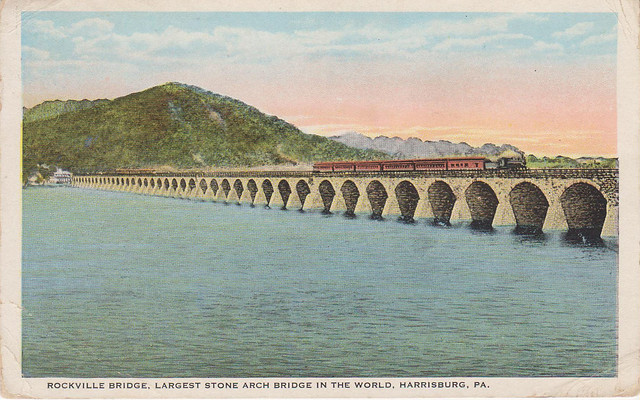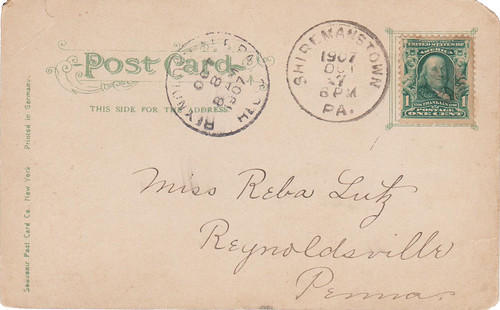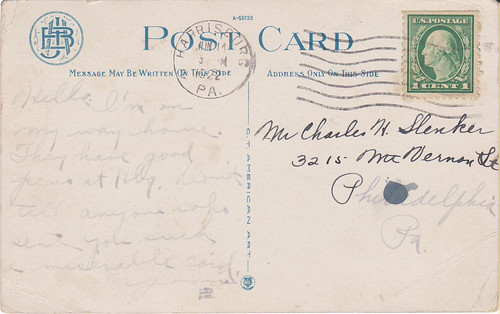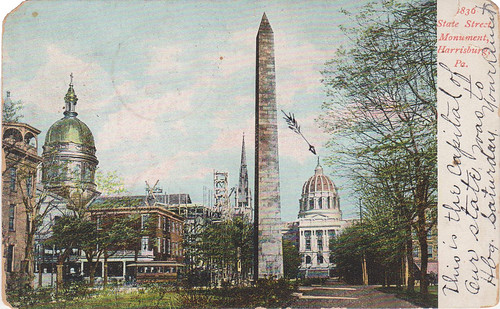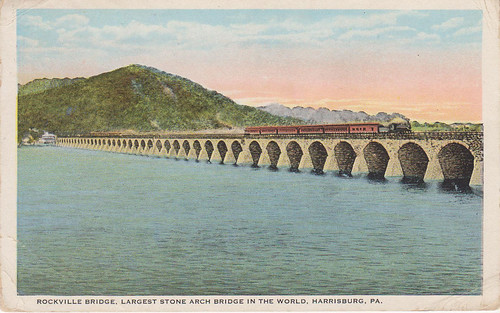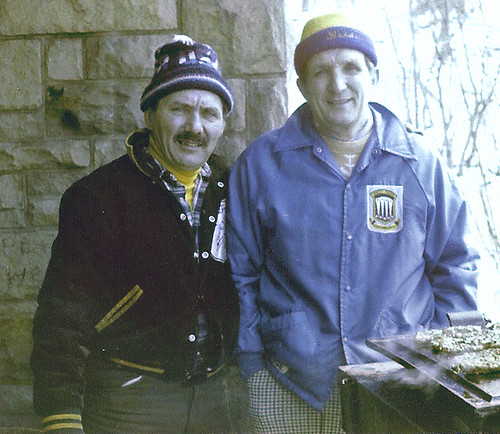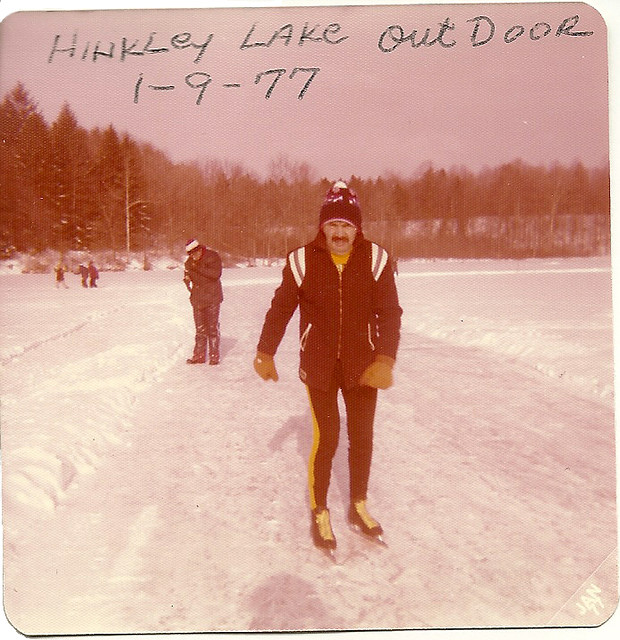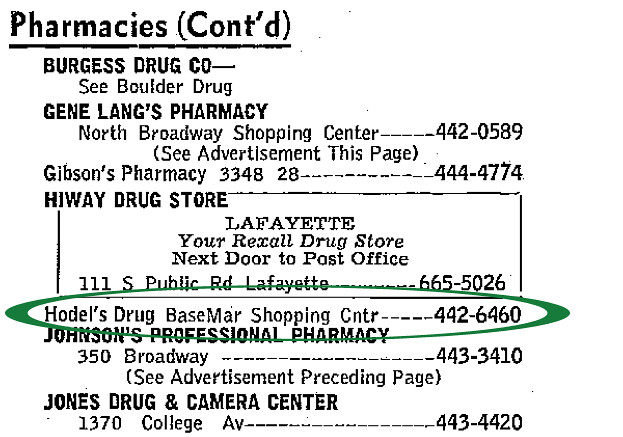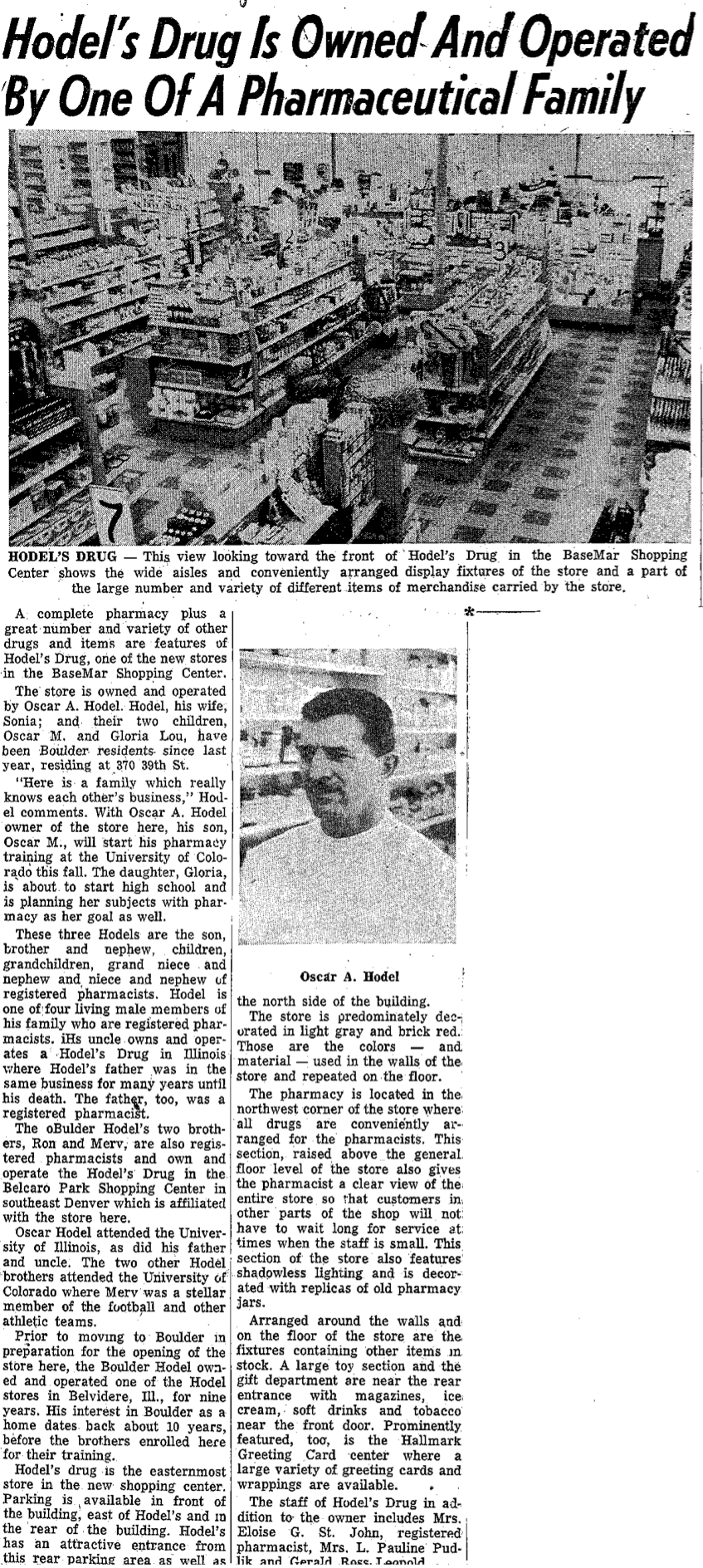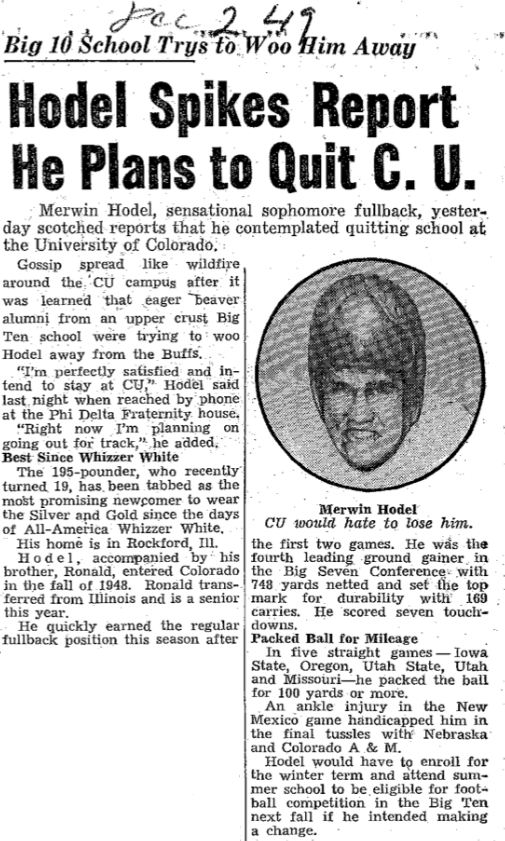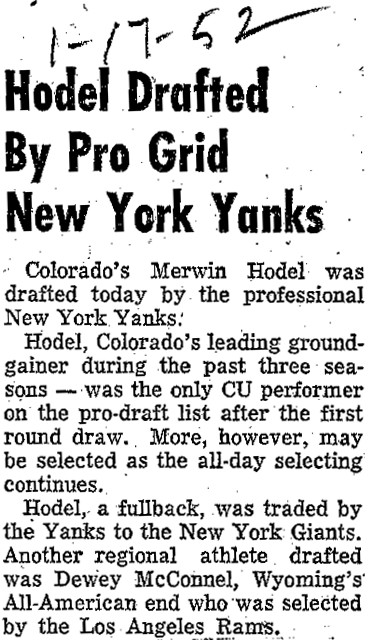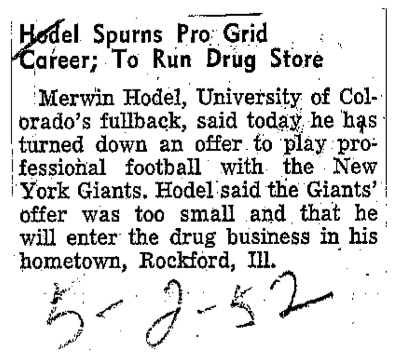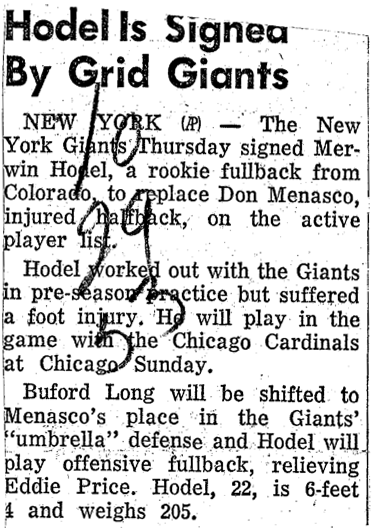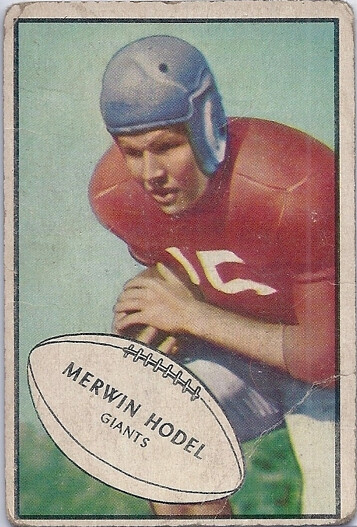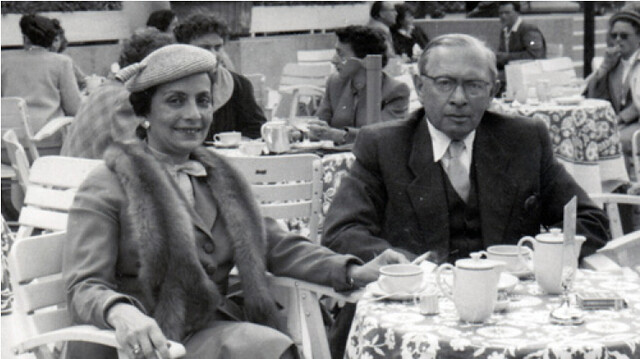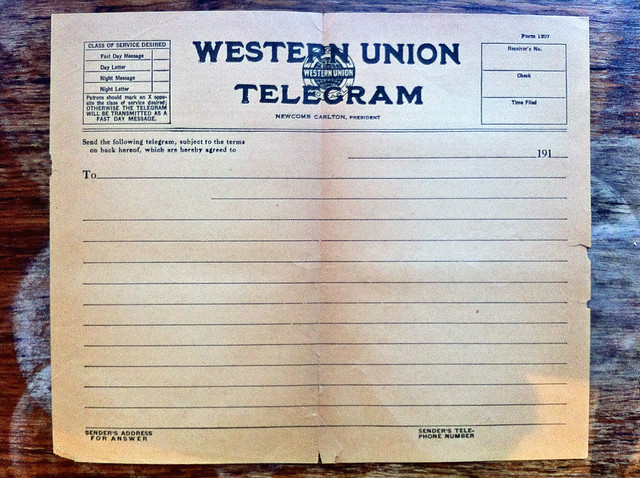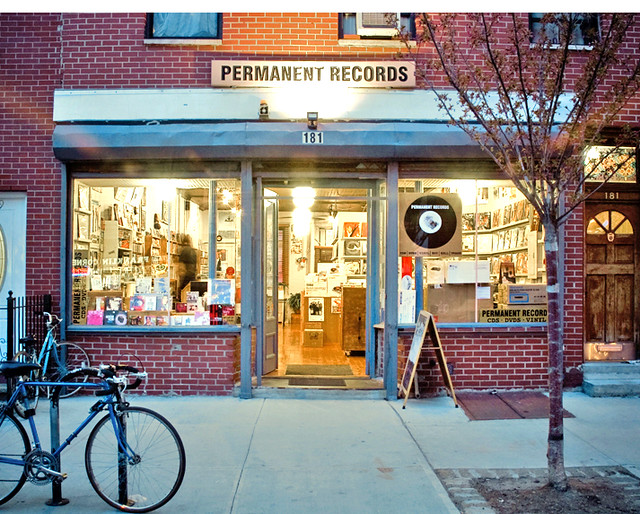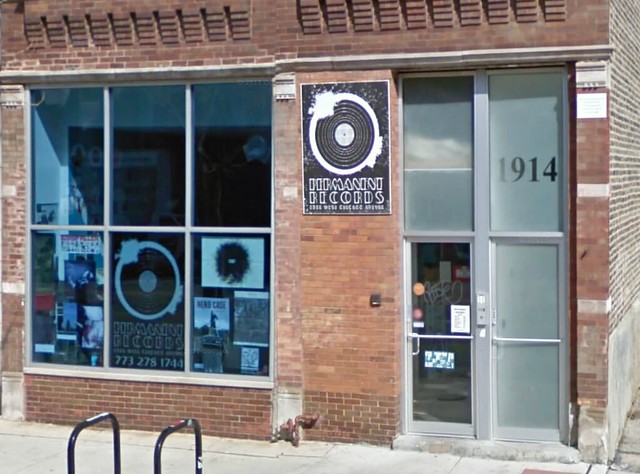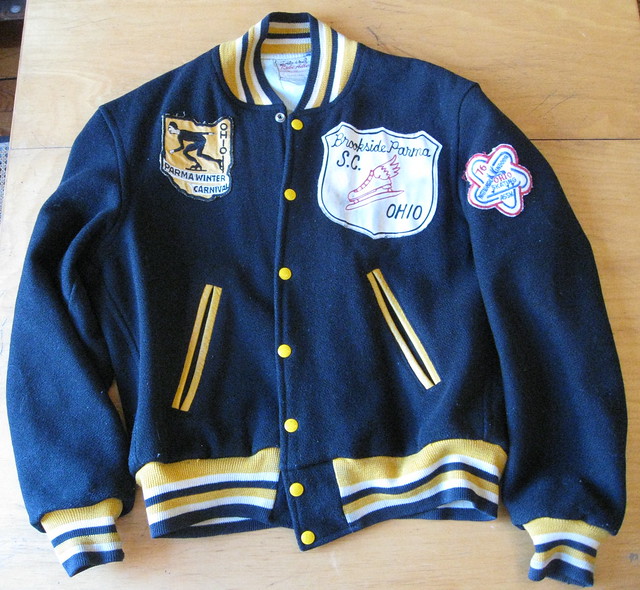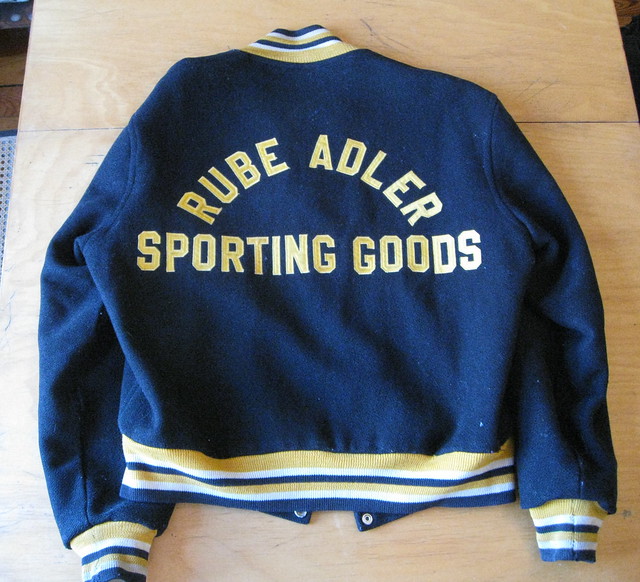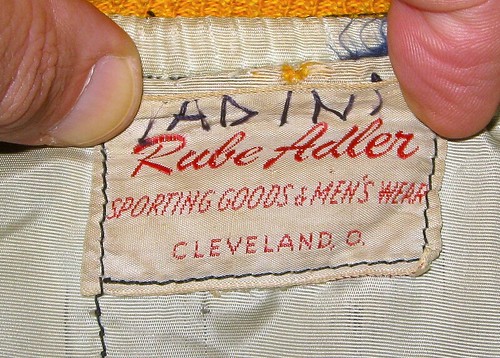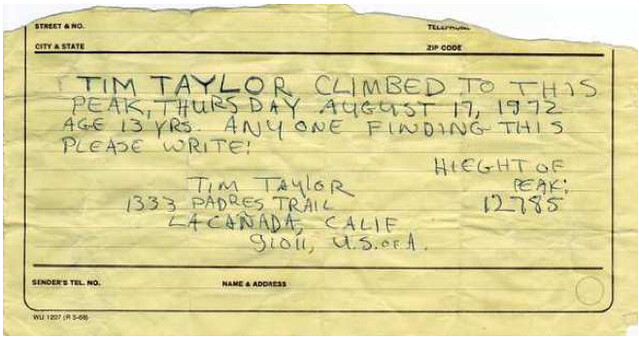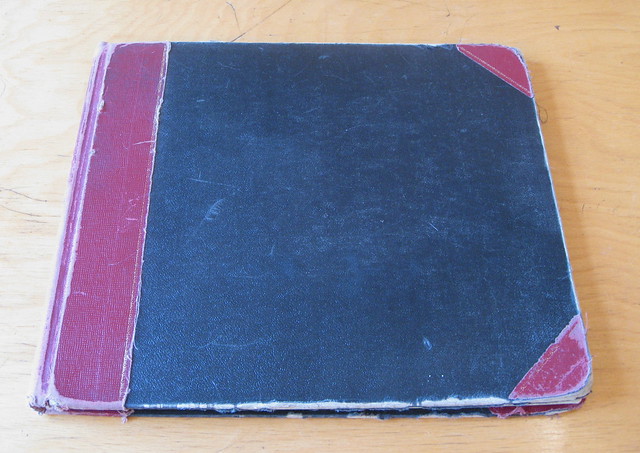

Click photos to enlarge
Remember the mental hospital patient ledger that I recently wrote about? I'll have more to say about that shortly-ish (it's a lot of information to process, plus I'm still assessing the ethical implications), but in the meantime that ledger has gotten me curious about the larger world of vintage ledgers in general, so I've been seeking some of them out.
One of the most interesting ones I've acquired, which I found on eBay, is shown above. It tracks a little over nine years' worth of daily revenue figures (and lots of other things, which I'll get to in a minute) for Hodel's Drug, a now-defunct pharmacy in Boulder, Colorado. The ledger 152 pages and fairly large -- 13" by 15" when closed, and 30" wide when opened. The hardcover binding is thick, and the whole thing feels heavy and substantial, almost indestructible. If my apartment burned down, I feel like this is one of the items that would survive the inferno.
I wanted to know more about Hodel's Drug, so I did some rudimentary Googling and came up with this obituary for Sonja Hodel, who died earlier this year. The obit says she "was married to Oscar A. Hodel, longtime proprietor of Hodel's Drug in Basemar Shopping Center, who died in 1979." Based on this, and on a few other clues, I'm pretty sure the ledger was filled out by Oscar. (I've tried to find an obituary for Oscar but have so far come up empty. Update: PermaRec research volunteer Cate Bloomquist has turned up this obituary for Oscar. It doesn't add much to the story, although it does prove for the umpteenth time that Cate is a much better researcher than I am.)
The ledger begins in January of 1963 and goes through March of 1972. For the first few years of the ledger, each month got its own two-page spread, as shown in the second photo at the top of this page. But in April of 1966, Oscar changed the format to one page per month, instead of two, as you can see here (for all of these photos, you can click to enlarge):
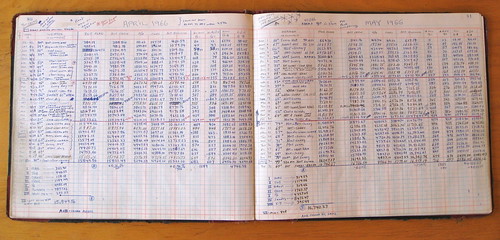
The ledger's primary function was apparently to track the shop's daily revenue in a variety of sales categories -- magazines, tobacco, liquor, beer, prescriptions, non-prescription drugs, sundries (always a great category), and so on -- along with daily figures for sales tax, excise tax, and the like. I'm sure someone could analyze the numbers and discern assorted business trends and sales cycles. Maybe I'll get around to doing that myself one day.
For now, though, I'm much more interested in the other information and notes scattered throughout the ledger. Cumulatively, they suggest that the ledger was really more of a personal journal, and that Oscar was a bit of an obsessive diarist. I'm a bit obsessive about documenting certain things myself, so I felt something familiar and even comforting as I explored the ledger -- the sense that I was encountering the work of a kindred spirit. Still, Oscar took things a lot further than I ever have.
For starters, Oscar appears to have been rather fixated on the weather. Every single daily ledger entry begins with the day's high temperature and a description of the weather, with atypical or severe conditions noted in dramatic lettering:
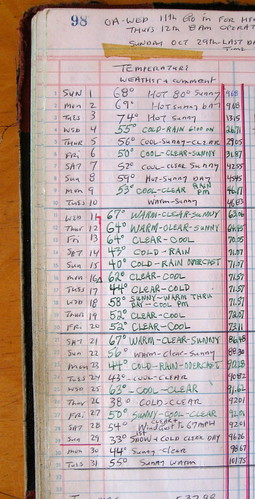

I'm sure Boulder's daily weather history is easy enough to find on the internet these days. Still, it's kind of amazing that Oscar's drug store ledger also serves as a de facto meteorology archive for the city. I happen to have been born during the period covered by the ledger, so I looked up my birthday -- March 21, 1964 -- and found that it was an unusually warm day, but that it snowed just a few days later (not that I was anywhere near Boulder at the time, but it's still interesting):

I especially like the top of the page for June of 1965, where Oscar noted that a tornado had taken place in Colorado Springs and then drew a little twister to punctuate the event:

But weather wasn't Oscar's only obsession. Looking through the ledger, several other themes become apparent:
1. Current events. Significant news events were annotated at the top of the pages for the months in which they occurred. Here, for example, is the top of the page for November of 1963, when John F. Kennedy was assassinated, along with the ledger entry indicating that the store was closed on the morning of his funeral:
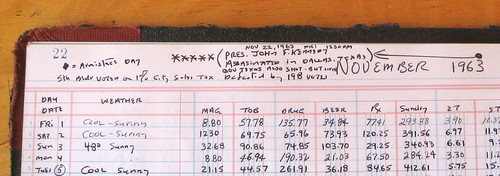
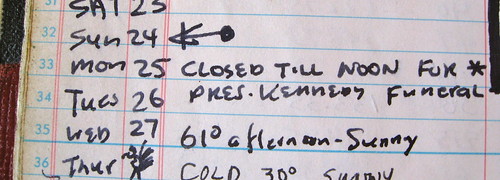
When Lyndon Johnson was re-elected a year later, this too was noted on the top of the appropriate page:
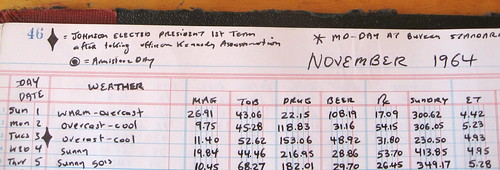
April of 1968 was a particularly busy month, with Martin Luther King Jr.'s assassination, a total eclipse, Johnson's announcement that he would not seek re-election, the start of Daylight Savings Time, and more:

And here are the notations for Robert Kennedy's assassination (June of 1968) and the Neil Armstrong's first steps on the moon (July of 1969):


2. Holidays. Oscar had a fairly consistent protocol for denoting holidays in the ledger. The entry for Valentine's Day, for example, always included a little heart:

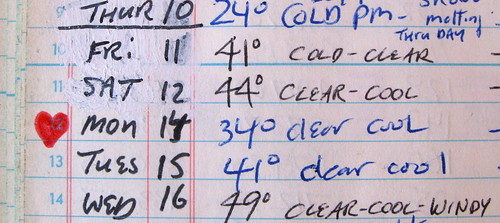


As you can see, sometimes the heart was red, and sometimes not. Maybe this was just a function of whether Oscar had a red pen within easy reach, but I doubt it. Almost everything about the ledger feels programmatic, like it was done for a reason, so I suspect there was a color-coding system for the hearts, but I haven't cracked that code yet.
The hearts are nice, but my favorite thing about the entire ledger is the crude little turkey that Oscar drew each year to designate Thanksgiving:

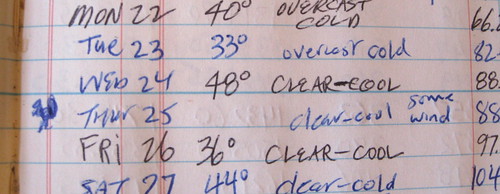
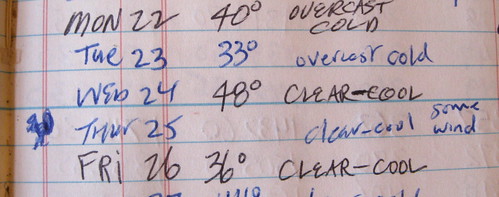
How great is that?! Other holidays got their own symbols, but the hearts and the turkeys are the best ones.
3. Traffic. The ledger has repeated references to traffic developments in the Boulder area (presumably because they might affect business at Hodel's Drug), such as this newspaper clipping:
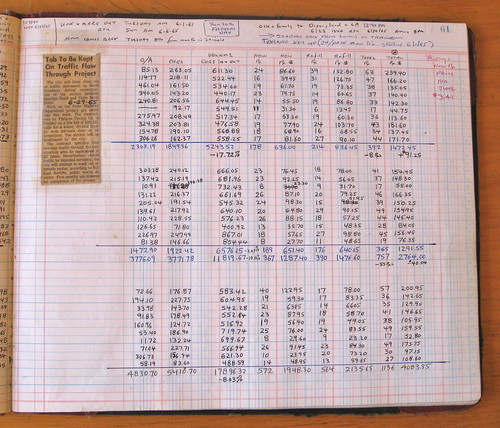
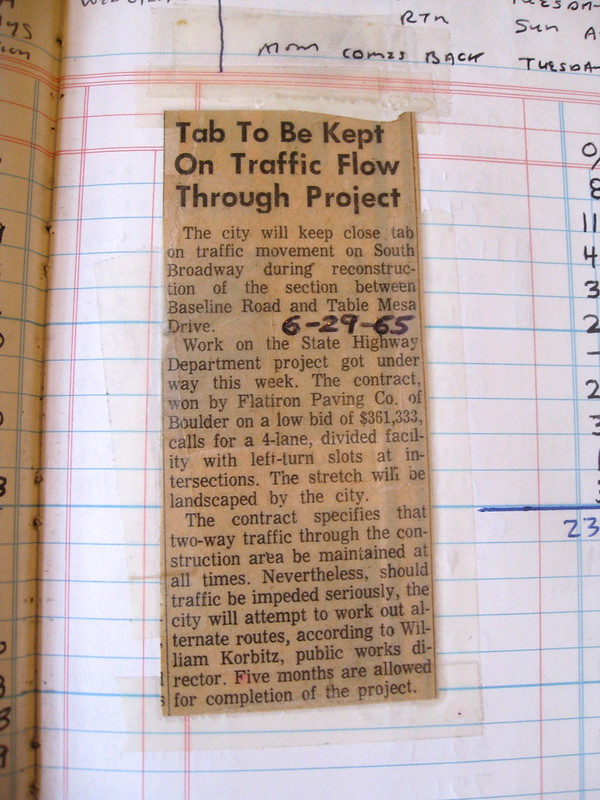
Some of the daily entries also have traffic-related notes, such as this mention of an intersection being closed:

4. Family. There are many, many notations regarding family developments. Fortunately, that obituary for Oscar's wife, Sonja, lists the names of many of the family members, so I was able to decipher many of the relationships and references.
Let's start with Sonja herself. If you look again at that obituary, you'll see that the headline lists her as "Sonja" but the text refers to her as "Sonia." Interestingly, this inconsistent spelling also appears in the ledger:
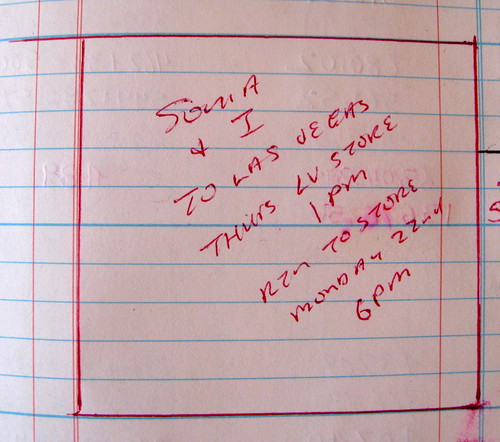


There are also many references to Oscar and Sonja/Sonia's daughter, Gloria, most notably the announcement of her marriage to a man named Dave in August of 1971:

The wedding note was good to see, because Dave had apparently been involved in a serious motorcycle accident a little over two years earlier:

In a somewhat more mundane development, Oscar put snow tires on Gloria's car in December of 1968, which I mention only because it shows the degree to which Oscar used the ledger as a personal journal:
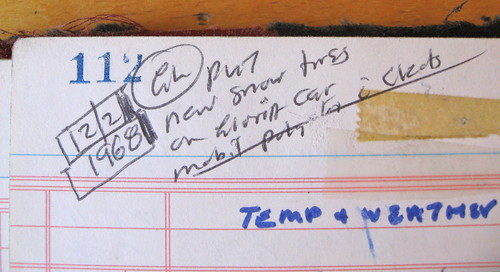
My favorite family-related notation is from August of 1969, when Oscar managed to combine several of his passions (family, weather, cars/traffic, etc.) into the following note:

In case you can't make out the handwriting, it says, "Temp 8/8 Friday officially 101º -- Sonia, Gloria, boys + I go to Colorado Springs (Cave of Winds). Air conditioning not working in Cadillac."
5. Sports. There are assorted references to sports throughout the ledger -- mostly football, but not exclusively. For the January 1964 page, for example, Oscar listed the winners of the various New Year's Day bowl games:
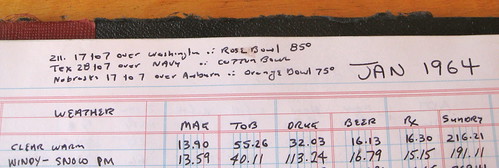
Note that Oscar also listed the temperatures for the Rose Bowl and Orange Bowl. He really liked his weather.
Sports and weather intersected once again in this note about the 1967 Indianapolis 500 being rained out:
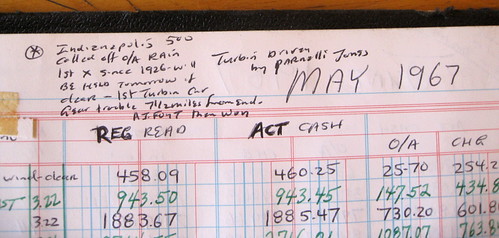
Oscar also attended some sporting events in person, as you can see from this note regarding a Broncos/Jets game in Denver:

As you can see, Oscar went to the game with "OCKd." That abbreviation appears many times in the ledger, but I'm not certain who it refers to. According to Sonja/Sonia's obituary, she and Oscar had a son named Oscar -- maybe "OCKd" is him? Not sure.
6. The shop. As you'd expect, there are lots of notes relating to Hodel's Drug itself. Some of these are explainers for certain sales figures. The prescription revenue at the beginning of February of 1966 was higher than usual, for example. Why? Here's why:
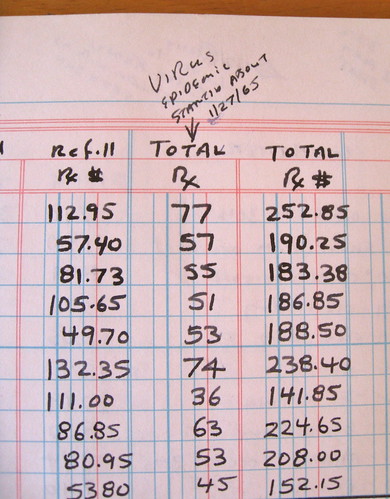
Similarly, when tobacco revenue spiked in July of 1964, Oscar provided an explainer for that as well:

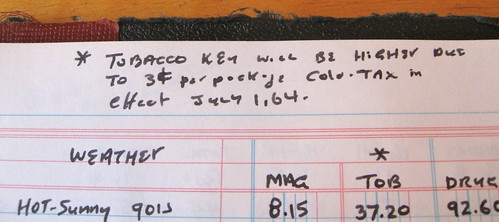
There are also some notes regarding the maintenance of the shop, like these mentions of taking out a wall and pouring a new floor:

Hodel's Drug apparently underwent a remodeling for the Christmas season in 1966. It must have been deemed a success, because it was repeated every subsequent year except for 1969:



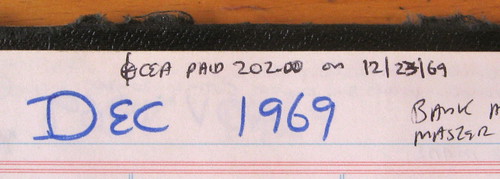


Hmmm. What happened in 1969? Why no Christmas remodeling that year?
There are indications that Hodel's Drug either closed or moved in the spring of 1972. The first sign of this comes at the bottom of the page for December of 1971, where there's a note about giving up the shop's longstanding beer license:
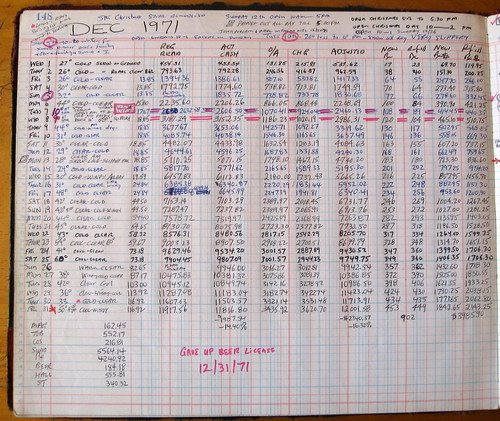
The reference to the beer license is repeated at the top of the following month's page. But the bigger news is at the bottom of that page, which indicates that Oscar had given his landlord a three-month notice of lease termination:
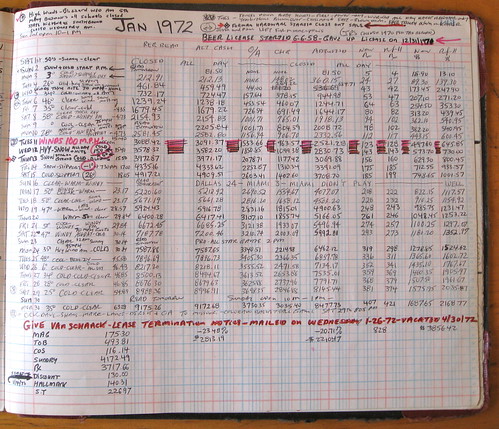

References to the impending end of the shop's lease are repeated on the pages for the next two months:

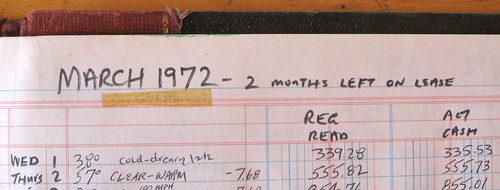
And that, rather maddeningly, is where the story ends. After March of 1972, the ledger was full, with no pages left for what was apparently the shop's final month. Did Oscar purchase another ledger for April, just to record the numbers for that last month? I'd like to think he did, if only because he was such an endearingly compulsive documentarian that it's hard to imagine him without his journal. Surely he must have kept tallying sales figures and jotting down weather conditions down to the very last day, no?
— — —
The Hodel's Drug ledger is an amazing document of a business and a family. My initial instinct was to track down some of Oscar and Sonja/Sonia's children or grandchildren (should be easy enough, since I know their names and at least some of them are probably still in the Boulder area) and see if they wanted this family heirloom returned to them. But first I wanted to know the route that the ledger had taken on its way to me. How had it ended up on eBay in the first place?
So I contacted the eBay seller (who, judging by his eBay profile, is an experienced seller with tens of thousands of sales) and asked how he'd acquired the ledger. The answer surprised me: "It was a consignment." In other words, someone was in possession of the ledger, figured it might have some value, and gave it to an experienced vendor to sell.
It seems likely that this person was a member of the Hodel family. Sonja/Sonia died just eight months ago, so perhaps the ledger had been stored in her home and was flagged as a likely resale item when her family went through her personal effects after her death. Or maybe the family held an estate sale and the ledger was purchased by someone who figured it might have resale value. Either way, it suggests that the family didn't care about holding onto the ledger, so maybe I shouldn't get in touch with them after all. Hmmm.
The eBay seller wouldn't tell me the consignor's identity but offered to pass along my contact info to the consignor. I accepted that offer. No response from the consignor so far, though.
So now I'm rethinking my original plan of getting in touch with the Hodels. Instead, I think I'll contact the Boulder History Museum and see what they have to say. Stay tuned.
